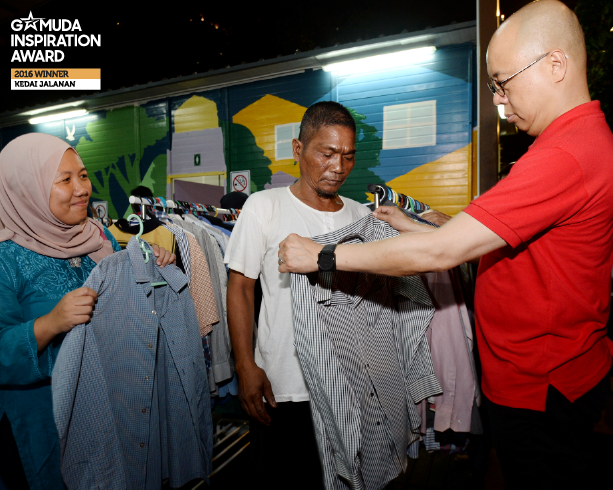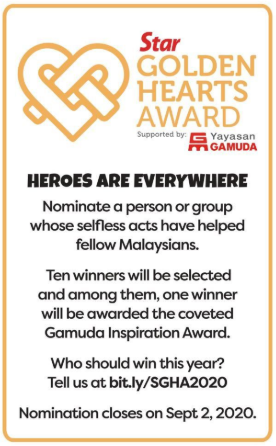Making life better in meaningful ways

UNSUNG, everyday heroes walk among us in plain sight, often unnoticed.
For some, however, their unpublicised efforts have resonated with fellow Malaysians who have nominated them for the annual Star Golden Hearts Award (SGHA) now in its sixth year, and more significantly, earned them the coveted Gamuda Inspiration Award (GIA) supported by Yayasan Gamuda – a special SGHA accolade given to just one out of 10 SGHA winners each year.
The GIA, in recognition of deeply meaningful and impactful community-building efforts, earns the recipient the one-off grant of RM50,000, and as The Star caught up with past GIA recipients, the money has clearly been a huge help in furthering these incredible, disparate individual causes enormously.
Prosthetic arms for kids
Sujana Rejab, recipient of the GIA in 2019, was recognised for having created 3D-printed prosthetic arms for 50 disabled children.
Affectionately known as Pak Su, the former teacher initially utilised online resources such as Google and YouTube to teach himself the process of 3D printing, successfully creating the first 3D-printed arm for a disabled child in 2015 – this after stopping duty as a teacher in 1997, taking on a computing programming course, working at a computing firm for a few years before founding his own computing business in 2004. He’s come a long way since.
The money from the GIA, says Pak Su, has helped him tremendously to “do more research and development, R&D that has been suspended, ” since, as he laments, he has not received any government funding or aid to assist him with the research.
Seeking government agency funding for research into improving the sensor systems and prosthetic design for these children is a priority for Pak Su, who has since managed to create a prototype for a 3D electronic prosthetic device, of which the cost of a single unit comes to RM7,500.
In that respect, he says, the award money has truly helped with the research required to produce a prototype.Three children have so far received these 3D electronic prosthetic arms, and during the MCO period, Pak Su has managed to create another four units of these arms, intended to be donated to two children and two adolescents.
He has also received support from Sadaqa House in bearing some of the cost for the research into and creation of the prosthetic arm for disabled children whose families are in the B40 segment.
Kindy in Penan village
In another part of the country, children were also benefiting from the efforts of a group that calls itself Barefoot Mercy, a Sarawak-based volunteer organisation whose co-founder Anna Wee went on to – with the help of many others – complete the construction of Tadika Pawah for rural kids in Long Lamam, a remote Penan village deep in Sarawak’s Baram district.
That was in 2017, and Barefoot Mercy, in addition to being one of the 10 SGHA winners that year, went on to gratefully receive the GIA award. The recognition, says Wee, “was the best surprise for all our years of journey since our inception in 2011.”

Barefoot Mercy began as a three-woman team with “no experience or resources, ” says Wee, “and the name captures the essence of why we do what we do, that is to serve the underserved and marginalised. ‘Barefoot’ attributes to a bare state of being, without basics and a connection to earth and nature and mercy denotes vulnerability and a cry for inclusivity.”
The group has since achieved much in helping in rural electrification works for the kindergarten and enabling educational resources for a generation of Penan preschoolers who belong to a nomadic tribe of hunters that number fewer than 20,000.
“The award prize money was timely, ” says Wee. “Winning the award enabled us to proceed planning for phase two which is the construction of the boarding house, community dining hall, kitchen and bathrooms.
“The Gamuda Inspiration Award has helped us hugely in achieving our objectives for this initiative, providing the much-needed funds to continue the second phase of the project.”
Clothing the homeless
While rural preschoolers in Sarawak get a taste of early education, the homeless in a central area of the nation’s capital city get a taste of being clothed with dignity.
Kedai Jalanan, which began as a class project between Universiti Malaya lecturer Dr. Rusaslina Idrus, and her students, has become more than what it began as, which was initially a way to allow the homeless, the needy and marginalised communities to clothe themselves with dignity.
The project, which earned this group recognition from the SGHA in 2016 as well as the coveted GIA, has become, in the words of Rusaslina, a community focal point. What was the once-a-month Kedai Jalanan set-up has now expanded to include art and community interaction activities.
Volunteering at soup kitchens such as Dapur Jalanan where Rusaslina – a trained anthropologist who lectures in gender studies – and volunteers would donate non-food items, grew into a realisation that the clothes that were dropped off by people were often left in a disorganised pile, a pile that “did not allow women and children to look for the clothes in a dignified way, ” she says. Moreover, donors often donated used clothes that were inappropriate for these people.The noble intention to allow such communities to see what would fit and suit them from these piles of donated hand-me-downs led to Kedai Jalanan, a pop-up presence resembling an organised space housing these donated items for the homeless and for urban families who are exceedingly poor.
Moreover, donors often donated used clothes that were inappropriate for these people.The noble intention to allow such communities to see what would fit and suit them from these piles of donated hand-me-downs led to Kedai Jalanan, a pop-up presence resembling an organised space housing these donated items for the homeless and for urban families who are exceedingly poor.
Kedai Jalanan is still active in its fifth year, and the GIA has enabled Rusaslina and her team of volunteers to have proper storage space and lease a storage facility at a faculty in UM for all the donated items.
“People have been generous with donations, which is not just clothes but also necessities like soap, toiletries, ubat nyamuk and minyak angin, ” she says. The storage facility has been helpful in organising these donations.
When donations of items such as soap are in short supply, Rusaslina and her volunteers purchase these items and even commission a barber to cut the hair of the homeless and the urban poor.
Additionally, Rusaslina has found the money to be helpful in galvanising resources to create a database and map of volunteer organisations, NGOs and services across several areas as a way to better coordinate and locate voluntary and charitable efforts, such as medical help.
Lasting social impact
Yayasan Gamuda head Ts. Sharifah Alauyah commends these winners’ efforts “where lasting, transformative social impact is possible, ” underscoring Yayasan Gamuda’s sustained and unwavering commitment to community-building efforts, education and social change – evident in its continued support of the SGHA.
Efforts that promote and nurture educational, social and economic participation for the long-term betterment of society, she says, serve to add to a greater sense of communal responsibility, which she hopes to see continued with new nominations for this year’s SGHA. With such initiatives being recognised, we can all hope for future generations of big-hearted givers.

